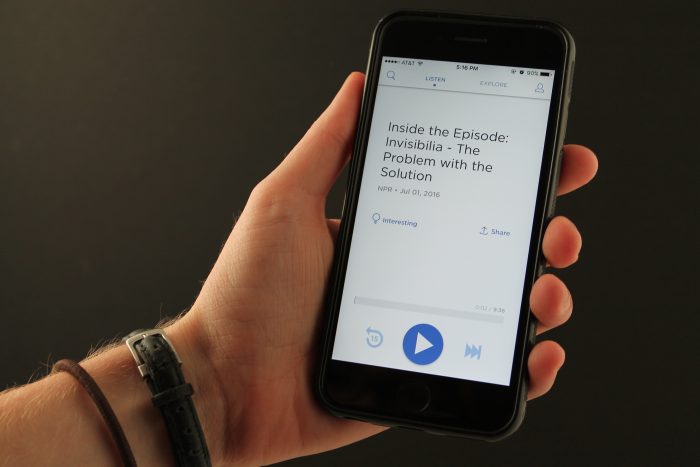
But even without full access to the airwaves, NPR’s app and podcasts are busy promoting one another. A prime example: NPR’s highly successful Invisibilia, currently in its second short-run season. The podcast, dedicated to the “invisible forces that control human behavior,” is using NPR One as a home for bonus content not available in the main podcast feed, pushing the show’s fans to check out the app.
The producers behind the show work with hosts Lulu Miller, Hanna Rosin, and Alix Spiegel on exclusives include sneak previews of new episodes and extra revealing minutes of the podcast not featured in the original recording.
Can’t wait til Friday for our new ep? Listen to this exclusive preview on the @nprone app: https://t.co/5hNoGcrAEc https://t.co/XU1wDNV4eI
— Invisibilia (@NPRinvisibilia) June 29, 2016
Go inside the episode with @aspiegelnpr and @lmillernpr exclusively on the NPR One app https://t.co/ItoNAoCBoKpic.twitter.com/mViW8ZnJ1X
— Invisibilia (@NPRinvisibilia) July 6, 2016
Viet Le, a content programmer for NPR One, and Nick DePrey, a content strategist, use bonus content to promote the show and attract users to the app, which curates NPR programming based on the interests of its users. Working with all shows across NPR’s podcast platform, the use of exclusive content has contributed to doubling the number of NPR One listeners over the course of the past year. “The results have been worth the efforts and have driven listeners in the thousands to the app,” says DePrey.
Unlike most NPR podcasts, Invisibilia operates on seasonal rather than year-round basis — which means there’s a bit more pressure on its promotional strategy to build audience than with shows that become a weekly habit for listeners. Having launched its second season on June 17, the NPR One editorial team took advantage of season one content to promote the release. “We took excerpts from the first season and played it for NPR One listeners in our News Flow,” says Le. Playing the excerpts in a “best of” fashion, users that “liked” the content within the app received an email allowing them to opt in to receive information on season two before its release.
Operating on seasonal basis due to its higher-than-usual research and production requirements, Invisibilia allows listeners to explore the content further than usual podcast lengths allow. DePrey remarks the behind-the-scenes content from “The Personality Myth,” a season two episode as particularly well-received on social media. “Both in terms of their consumption of that actual piece and on Twitter, people were like, ‘Wow that is so cool!'” says DePrey.
I love @NPRInvisibilia so much. This week’s episode and bonus episode on mental illness are fascinating. Plus Invisibilia is fun to say.
— Danielle Johnson (@dwhren) July 5, 2016
This Invisibilia bonus podcast is blowing my mind. Well played, @npr.
— rahul (@terminal4) February 12, 2015
The podcast drives audiences to the bonus material in a variety of ways. On social media, Invisibilia shares direct links to the bonus content, says Le. “In the middle of the podcast, midroll, they’ll say ‘Hey, type Invisibilia [in NPR One], et cetera, et cetera’…We give some language to the hosts so that they can tell their listeners.” Having produced nearly 50 exclusives in total across the platform, NPR One maintains this strategy for a variety of its podcasts as well as radio shows. “The radio has a tight clock. NPR One allows you to go deeper with your reporting,” says DePrey.
(Invisibilia is also doing plenty of other interesting cross-media promotions. This week’s episode is being promoted via a video shot with Elle magazine, and it’s created a video of a live performance collective recreating a scene from another episode.)
Does clothing have the power to change us on the inside? @NPRinvisibilia & @ELLEmagazine team up to find out: https://t.co/kngQj8RzGd.
— NPR Extra (@NPRextra) July 21, 2016
Le and DePrey finds NPR One especially beneficial for reporters, giving them an extended platform to experiment with longform and test work that could eventually become a podcast. One example: An upcoming politics podcast was beta tested in NPR One, allowing listeners to give feedback and learn more before its official NPR release. “Through listener data and seeing where people drop off, we can tell what was working and what wasn’t, and that helps shape the politics podcast going forward,” says Le.ICYMI, here's a story about a terrifying backyard robbery that takes an extraordinary twist: https://t.co/fwkEcFGR2O – via @NPRinvisibilia
— Robin Lubbock (@RLubb) July 21, 2016
The experimental nature of NPR One allows it to be freeform, personal to the listener, while also the ultimate beta test of what could impact the future of NPR. “Much like the radio, we saw an opportunity to mix in pieces that otherwise didn’t have a home and use that as a good reason to use NPR One,” says DePrey. “There is a lot of stuff on there that you can’t hear anywhere else, and that is a core part of the product.”
Through NPR One, serious Invisibilia fans find an extended community, uniting around content that cannot be found anywhere, becoming insiders within their fanbase. Applied to other NPR podcasts, the strategy is on its way to making a large impact answering the question: How can NPR meet its listeners where they are? “We’re playing around with this all the time,” says Le. “We’re trying this out a million different ways. We’re still trying to figure out what works best in getting that material to the listeners. “